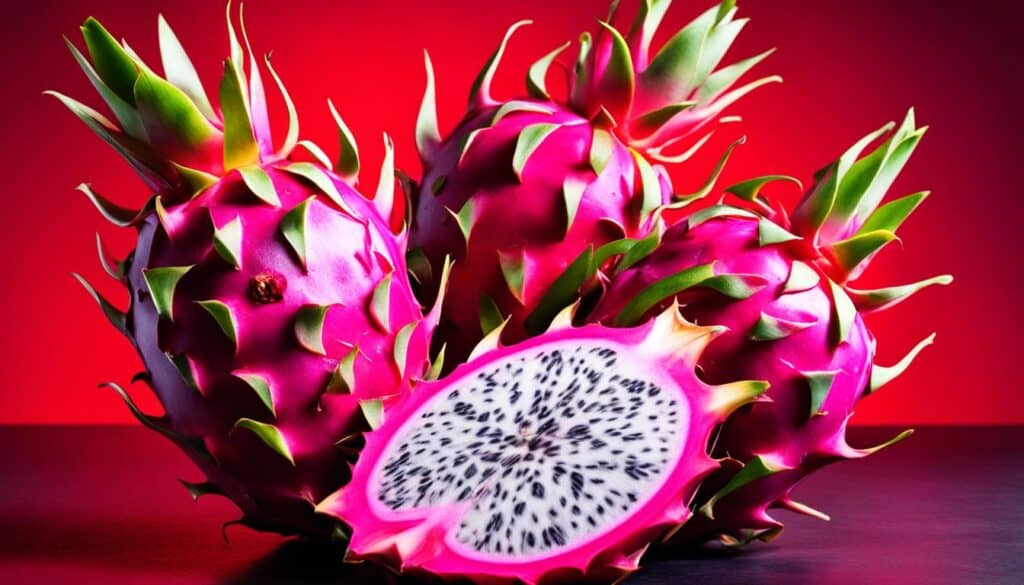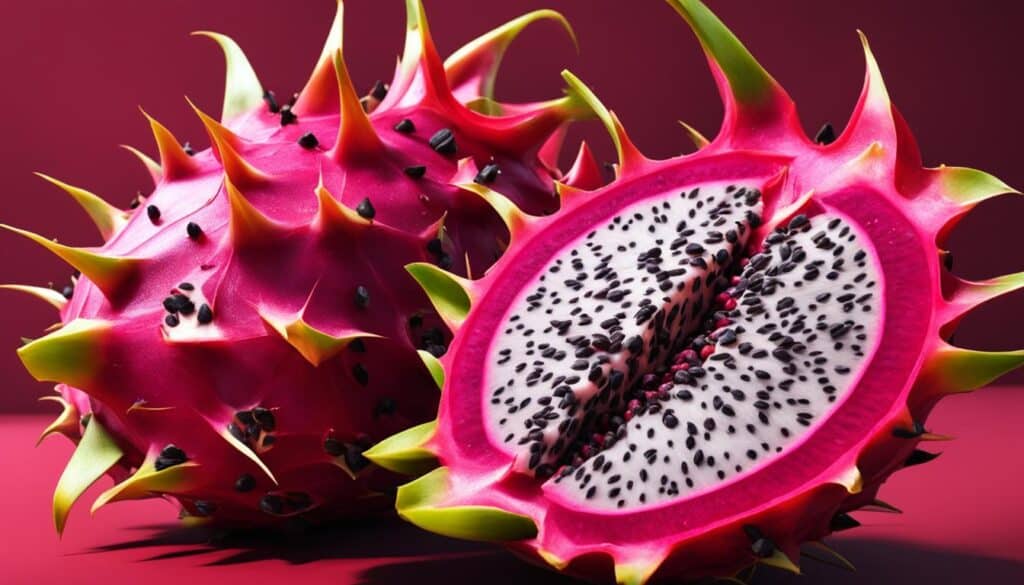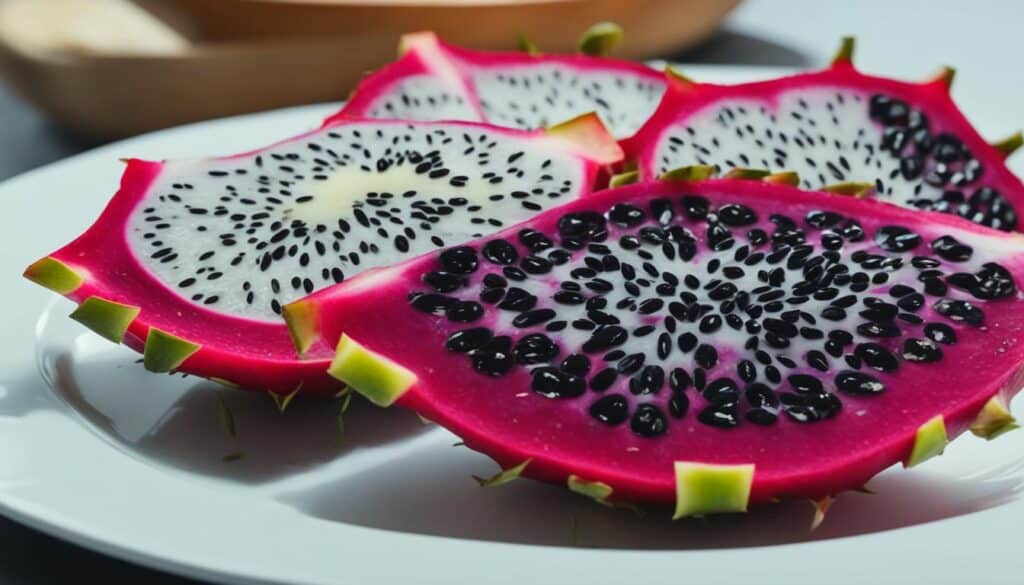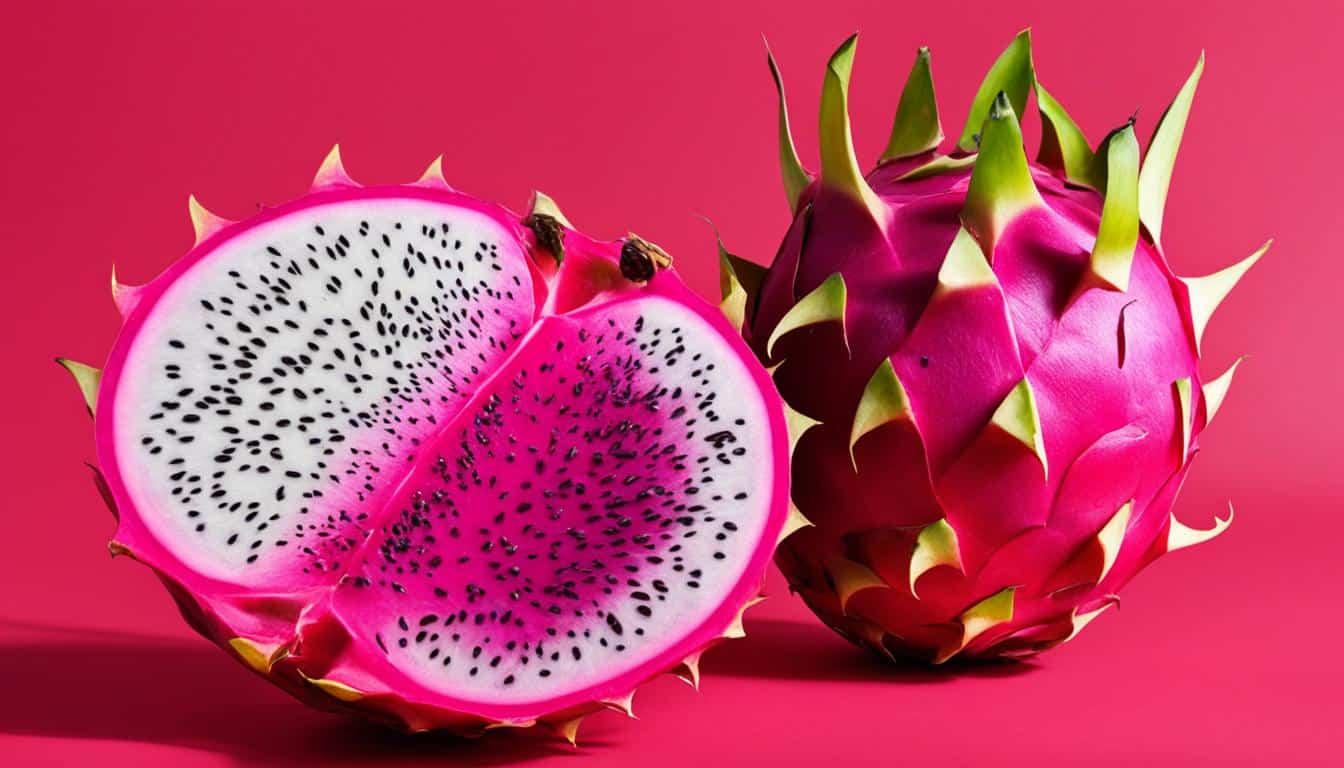Dragon fruit is a fascinating tropical fruit that comes in a variety of colors, but have you ever wondered which dragon fruit is red inside? In this article, I will explore the different types of dragon fruit with red flesh, also known as red dragon fruit. We will delve into the taste, nutritional differences, and visual characteristics of red dragon fruit.
From there, I will highlight some popular varieties and discuss the culinary uses and storage options for this vibrant fruit. Finally, we’ll discover the mythical origins and cultural significance of red dragon fruit. So, let’s dive into the world of red dragon fruit and uncover its hidden treasures!
Key Takeaways
- Red dragon fruit has a sweeter and juicier taste compared to the white variety.
- The red variant contains more antioxidants and vitamin C, but also more sugars.
- Red dragon fruit usually has scales that are closer together and a darker deep red skin color.
- Popular varieties of dragon fruit with red flesh include Red Jaina Natural Mystic, Zamorano, Costa Rican Sunset, and Strawberry Pear Cactus.
- Red dragon fruit can be enjoyed fresh, added to various dishes, or used in desserts.
Difference between Red and White Dragon Fruit
The main difference between red and white dragon fruit lies in their taste and sweetness. Red dragon fruit has a sweeter and juicier flavor compared to the white dragon fruit. The color of the flesh also affects the taste, as the redder the fruit, the higher the antioxidant content. However, the small black seeds in both varieties are edible and provide a kiwi-like texture.
Taste and Sweetness
Red Dragon Fruit: Sweet and Juicy
White Dragon Fruit: Mild and Less Sweet
Color and Antioxidant Content
Red Dragon Fruit: Higher Antioxidant Content with Redder Flesh
White Dragon Fruit: Lower Antioxidant Content with White Flesh
“The richness of red dragon fruit’s flavor makes it a popular choice for those seeking a sweeter and more indulgent tropical fruit experience.”
Enjoyed fresh, both red and white dragon fruits are refreshing and nutritious. However, if you prefer a sweeter and juicier taste, red dragon fruit would be the ideal choice.
Cross-Comparison
| Red Dragon Fruit | White Dragon Fruit |
|---|---|
| Sweet and Juicy Flavor | Mild and Less Sweet Flavor |
| Higher Antioxidant Content | Lower Antioxidant Content |
| Intensely Red Flesh | White Flesh |
| Edible Black Seeds | Edible Black Seeds |
Nutritional Difference between Red and White Dragon Fruit
When it comes to comparing the nutritional value of red and white dragon fruit, there are some notable differences. Let’s take a closer look at the nutritional content of both varieties:
| Nutrient | Red Dragon Fruit | White Dragon Fruit |
|---|---|---|
| Antioxidants | Higher amounts | Lower amounts |
| Vitamin C | Rich source | Lower source |
| Sugar Content | Higher content | Lower content |
| Fiber | Good source | Good source |
| Potassium | Provided | Provided |
| Phosphorus | Provided | Provided |
Red dragon fruit contains higher amounts of antioxidants, making it a great choice for those seeking a diet rich in these beneficial compounds. Additionally, red dragon fruit is a rich source of vitamin C, which is known for its immune-boosting properties and ability to support collagen formation. However, it is important to note that red dragon fruit also contains more sugars compared to its white counterpart. Both varieties are good sources of fiber, potassium, and phosphorus, which are essential for overall health and wellbeing.
So, whether you choose red dragon fruit for its antioxidant power or opt for the slightly milder white variety, both offer their own unique set of nutritional benefits.
“Choosing red dragon fruit for its antioxidant power or opting for the slightly milder white variety – both offer their own unique set of nutritional benefits.”
How to Differentiate between Red and White Dragon Fruit
When it comes to distinguishing between red and white dragon fruit, there are a few key features to look out for. These characteristics can help you identify the color of the fruit before slicing it open. Let’s take a closer look at the appearances and features of red and white dragon fruit:
Features of Red Dragon Fruit
Red dragon fruit tends to have scales that are closer together and more prominent on the fruit’s skin. The scales are often vibrant, with a deep red color. The fruit itself can appear oval or oblong in shape, measuring around 4 to 9 centimeters in diameter. The skin color ranges from bright pink to red-brown, giving it an eye-catching appearance.
Features of White Dragon Fruit
White dragon fruit, on the other hand, has wider scales and a more pinkish skin color. The scales may be less prominent compared to the red dragon fruit, and the fruit itself is typically larger in size. When it comes to taste, white dragon fruit is known for its mild and subtly sweet flavor.
While these features can provide a general indication of the fruit’s color, it’s important to note that they are not always definitive. Dragon fruit can sometimes surprise you with a different color than expected, adding an element of excitement to your culinary adventures.
To help you visualize the differences between red and white dragon fruit, here’s a simplified table:
| Features | Red Dragon Fruit | White Dragon Fruit |
|---|---|---|
| Scale appearance | Close together and prominent | Wider scales |
| Fruit shape | Oval to oblong | Varies in shape, larger |
| Skin color | Bright pink to red-brown | Pinkish |
| Taste | Sweeter and juicier | Mild and subtly sweet |
Now that you know the visual differences between red and white dragon fruit, you can confidently choose the variety that suits your taste preferences and culinary creations.
Varieties of Dragon Fruit with Red Flesh
When it comes to dragon fruit with red flesh, there are several enticing varieties available. Each variety offers a unique taste and visual appeal, making them a popular choice for dragon fruit enthusiasts. Here are some examples of red-fleshed dragon fruit varieties:
| Variety | Description |
|---|---|
| Red Jaina Natural Mystic | This variety is known for its intensely pigmented flesh and rich flavor. The deep red color of the flesh adds an enticing visual element to any dish or beverage. |
| Zamorano | The Zamorano dragon fruit variety offers a vibrant red flesh with a sweet and refreshing taste. Its distinctive flavor makes it a popular choice for juices, smoothies, and desserts. |
| Costa Rican Sunset | This variety is characterized by its stunning dark red flesh that resembles a beautiful sunset. Its flavor profile is a perfect balance of sweetness and acidity, making it a versatile ingredient in various culinary creations. |
| Strawberry Pear Cactus | The Strawberry Pear Cactus dragon fruit variety features a dark red interior with a sweet, strawberry-like flavor. Its unique taste and vibrant color make it a delightful addition to fruit salads and desserts. |
These are just a few examples of the red interior dragon fruit varieties available in the market. Each variety offers its own distinct flavor profile, allowing you to explore and discover your favorite. Whether you prefer the deep red hues of the Red Jaina Natural Mystic or the unique sweetness of the Strawberry Pear Cactus, there’s a red dragon fruit variety to suit every taste.

Visual Differences and Characteristics of Red Dragon Fruit
Red dragon fruit, also known as pitaya, is a tropical fruit with a visually striking appearance. Its unique characteristics make it easily distinguishable from other fruit varieties.
Size and Shape
Red dragon fruit typically has an oval to oblong shape, measuring around 4 to 9 centimeters in diameter. It’s slightly smaller compared to white dragon fruit, but size can vary depending on the variety and growing conditions.
Skin Color
The skin of red dragon fruit can range in color from bright pink to vibrant red-brown. This colorful exterior adds to its visual appeal and makes it stand out among other fruits. The skin is covered in fleshy, overlapping scales with green tips, giving it a unique texture and appearance.
Flesh Color
The flesh of red dragon fruit is a rich, dark red to crimson color. This vibrant hue is visually captivating and adds a pop of color to any dish or beverage. When cut open, the flesh reveals its intense color, creating a beautiful contrast against the green scales and adding to the overall allure of the fruit.
Texture and Seed
The flesh of red dragon fruit has a semi-firm and tender consistency, similar to that of a kiwi fruit. It melts in your mouth and has a refreshing juiciness. The flesh also contains tiny, edible black seeds that are reminiscent of those found in kiwi fruit. These seeds add a slight crunch and texture to each bite.

Culinary Uses and Storage of Red Dragon Fruit
Red dragon fruit is not only visually stunning; it also offers a delightful culinary experience. Its sweet and refreshing flavor makes it a versatile ingredient in various dishes and beverages. Here are some culinary uses of red dragon fruit:
- Sliced and added to fruit bowls, salads, or smoothies for a burst of color and sweetness.
- Used to make sorbets, ice creams, and other desserts for a unique twist.
- Simmered into syrups and sauces to enhance the flavor and add a touch of exoticism.
- Used as a garnish in cocktails to create visually stunning and flavorful drinks.
Note: Red dragon fruit can also be enjoyed on its own, as it is delicious when eaten fresh.
When it comes to storing red dragon fruit, here are some tips to keep in mind:
- Whole, unopened red dragon fruits can be stored at room temperature for a few days. However, if you want to extend their shelf life, you can place them in the refrigerator. Just make sure to consume them within a week.
- If you have sliced or cubed red dragon fruit that you want to store for longer, freezing is a great option. Simply place the slices or cubes in an airtight container or freezer bag and freeze for up to three months.
Now that you know how to store and use red dragon fruit, you can explore its culinary potential and create delicious recipes that showcase this vibrant and nutritious fruit.

Mythical Origins and Cultural Significance of Red Dragon Fruit
Red dragon fruit holds a special place in mythology and carries cultural significance in various regions. According to ancient legends, the origins of red dragon fruit can be traced back to the breath of a slain dragon. This mystical belief has contributed to the fruit’s symbolic association with victory.
In some stories, soldiers who tasted the dragon fruit considered the base of the dragon’s tail, known as “jaina,” to be the sweetest and most flavorful part. This perception added to the fruit’s allure and reinforced its connection to strength and triumph.
The cultural significance of red dragon fruit can be observed in Asian markets, where it is often referred to as jaina to pay homage to its mythical origins. This acknowledgment showcases the deep-rooted traditions and respect for symbolism that have been passed down through generations.

Dragon Fruit Myth and Symbolism
Dragon fruit’s symbolism extends beyond its mythical origins and cultural significance. The vibrant red flesh of this fruit is often associated with passion, vitality, and creativity. Its striking appearance and rich color have made it a popular choice for garnishing and enhancing the visual appeal of various dishes and beverages.
“Red dragon fruit symbolizes the flame of life, igniting the senses with its vibrant hue. It is a reminder of the power within us to overcome challenges, just as the dragon conquered its adversaries.”
The dragon fruit’s significance also transcends its symbolism and mythology. Its nutritional value, unique taste, and versatility in culinary applications have contributed to its growing popularity worldwide.
Dragon Fruit Legends and Stories
| Legend/Story | Region |
|---|---|
| The Breath of the Slain Dragon | Various cultures across Asia |
| The Dragon’s Tail | Indonesia |
| The Dragon Fruit of Victory | Mexico |
| The Divine Creation | Central America |
These stories and legends offer a glimpse into the rich tapestry of folklore that surrounds red dragon fruit. They inspire wonder and appreciation for the fruit’s history and symbolic significance, making each bite a truly magical and meaningful experience.
Conclusion
In conclusion, red dragon fruit is a delectable tropical fruit that offers a delightful combination of taste and visual appeal. With its unique flavor profile, red dragon fruit is a standout amongst other dragon fruit varieties. Its sweeter and juicier flesh, along with its vibrant color, makes it a popular choice for those seeking a tropical fruit experience.
Not only does red dragon fruit tantalize the taste buds, but it also provides numerous health benefits. Packed with antioxidants and vitamin C, red dragon fruit can contribute to a balanced diet and support overall well-being. Its natural sweetness and nutritional value make it an excellent addition to any healthy eating plan.
From fruit bowls and smoothies to sorbets and cocktails, red dragon fruit offers a myriad of culinary possibilities. Its versatility allows for endless culinary creativity, catering to both sweet and savory dishes. Whether enjoyed fresh or incorporated into various recipes, red dragon fruit adds a touch of tropical flavor and aesthetics to any meal.
In addition to its taste and culinary uses, red dragon fruit also holds cultural significance in various regions. Legends and stories associated with this vibrant fruit add an element of mystery and intrigue. From its mythical origins to its symbolism of victory, red dragon fruit is more than just a fruit; it is a symbol of cultural heritage.
FAQ
What is the difference between red and white dragon fruit?
Red dragon fruit has a sweeter and juicier flavor compared to white dragon fruit. Red dragon fruit also contains more antioxidants and vitamin C. Red dragon fruit often contains more sugars compared to the white variety.
How can I tell if a dragon fruit is red or white?
Red dragon fruit usually has scales that are closer together and a darker red color on the outside. White dragon fruit has wider scales and a more pinkish skin color. The fruit of red dragon fruit is typically smaller compared to the white variety.
What are the nutritional differences between red and white dragon fruit?
Red dragon fruit contains higher amounts of antioxidants and vitamin C compared to white dragon fruit. However, red dragon fruit also contains more sugars. Both varieties are a good source of fiber and provide potassium and phosphorus.
What are some varieties of dragon fruit with red flesh?
Some popular red-fleshed dragon fruit varieties include Red Jaina Natural Mystic, Zamorano, Costa Rican Sunset, and Strawberry Pear Cactus. These varieties are known for their intensely pigmented flesh and sweet taste.
How does red dragon fruit look and what are its characteristics?
Red dragon fruit has an oval to oblong shape with fleshy, overlapping scales, and green-tipped scales. The skin color can range from bright pink to red-brown. The flesh of red dragon fruit is dark red to crimson and has a semi-firm and tender consistency.
What are the culinary uses and storage recommendations for red dragon fruit?
Red dragon fruit can be eaten fresh, added to fruit bowls, salads, or smoothies. The flesh can also be used to make sorbets, ice creams, and desserts. Whole red dragon fruits can be stored at room temperature or in the refrigerator for a few days, while sliced and cubed flesh can be frozen for longer storage.
What is the mythical origin and cultural significance of red dragon fruit?
According to legends, red dragon fruit was believed to come from the breath of a slain dragon and symbolized victory. Dragon fruit is often referred to as “jaina” in Asian markets as a nod to its mythical origins. Soldiers considered the base of the dragon’s tail, known as “jaina,” the sweetest and best-tasting part of the dragon fruit.
How can I use red dragon fruit in recipes?
Red dragon fruit can be enjoyed fresh, sliced, and added to various dishes such as fruit bowls, salads, and smoothies. The flesh can also be used to make sorbets, ice creams, desserts, syrups, and sauces. It can also be used as a garnish in cocktails.





Leave a Reply